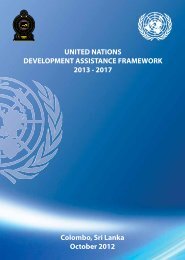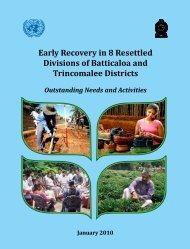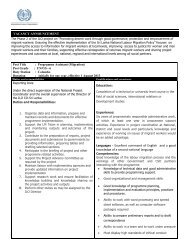Sri Lanka Human Development Report 2012.pdf
Sri Lanka Human Development Report 2012.pdf
Sri Lanka Human Development Report 2012.pdf
Create successful ePaper yourself
Turn your PDF publications into a flip-book with our unique Google optimized e-Paper software.
Figure T.2: Intensity of Poverty and Multidimensional Poverty<br />
Source: Computations by the report team of the Institute of Policy Studies of <strong>Sri</strong> <strong>Lanka</strong><br />
usingDepartment of Census and Statistics of <strong>Sri</strong> <strong>Lanka</strong> 2007b.<br />
The intensity of poverty (A) recalled reflects the proportion of<br />
the weighted components of indicators (d), in which, on average,<br />
poor people are deprived. The calculation of (A)was done only<br />
for those households identified as multidimensionally poor.<br />
For <strong>Sri</strong> <strong>Lanka</strong>, the intensity of poverty was 0.3966, perDHS<br />
2006/07 (Figure T.2 and Table A4). This indicates that an<br />
average multidimensionally poor person suffers 39.7 percent<br />
of the deprivations on the weighted indicators. The intensity<br />
of poverty among districts varied very narrowly, ranging from<br />
0.3695, or 37 percent, for Colombo District,to 0.4180, or 41.8<br />
percent, for Batticaloa District. In short, multidimensionally<br />
poor persons throughout the country face more or less the same<br />
intensity of deprivations.<br />
The percentage contributions of each dimension/indicator to<br />
multidimensional poverty reveal four distinct types of deprivations<br />
at the national level(Table T.5). Per DHS 2006/07, two health<br />
indicators are responsible for the highest contribution:‘at least<br />
one person in the household is malnourished’accounts for 30<br />
percent, and ‘at least one child in the household has died’accounts<br />
for 10.8 percent of deprivations. Two other high contributors<br />
are under living conditions: ‘household has no electricity’at 10.4<br />
percent,and ‘household uses firewood for cooking but does not<br />
have a separate kitchen’at 10.0 percent of the contribution.<br />
DHS2006/07 showed that more than one-fifth of children<br />
under five years of age are underweight. The situation on estatesis<br />
especially serious; the rate is as high as 30 percent. Although <strong>Sri</strong><br />
<strong>Lanka</strong> managed to bring down itsinfant mortality rate to 8.5 per<br />
1,000 live births in 2007, and the under-fivemortality rate to<br />
13.5 per 1,000 live births in 2003, the MPI contribution from<br />
the deaths of children in poor households is still high. Nutrition<br />
and child mortality in poorer households should be a major<br />
concern for policy makers and health planners.<br />
174<br />
sri lanka <strong>Human</strong> <strong>Development</strong> report 2012






